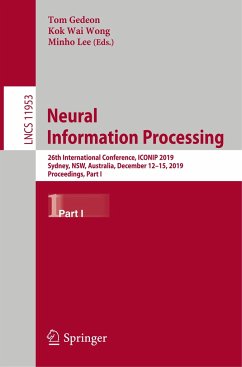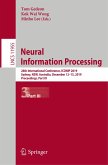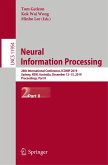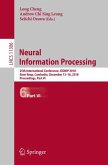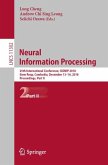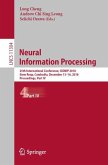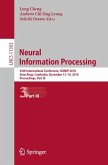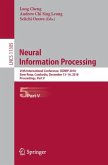Neural Information Processing
26th International Conference, ICONIP 2019, Sydney, NSW, Australia, December 12-15, 2019, Proceedings, Part I
Herausgegeben:Gedeon, Tom; Wong, Kok Wai; Lee, Minho
Neural Information Processing
26th International Conference, ICONIP 2019, Sydney, NSW, Australia, December 12-15, 2019, Proceedings, Part I
Herausgegeben:Gedeon, Tom; Wong, Kok Wai; Lee, Minho
- Broschiertes Buch
- Merkliste
- Auf die Merkliste
- Bewerten Bewerten
- Teilen
- Produkt teilen
- Produkterinnerung
- Produkterinnerung
The three-volume set of LNCS 11953, 11954, and 11955 constitutes the proceedings of the 26th International Conference on Neural Information Processing, ICONIP 2019, held in Sydney, Australia, in December 2019.
The 173 full papers presented were carefully reviewed and selected from 645 submissions. The papers address the emerging topics of theoretical research, empirical studies, and applications of neural information processing techniques across different domains. The first volume, LNCS 11953, is organized in topical sections on adversarial networks and learning; convolutional neural…mehr
Andere Kunden interessierten sich auch für
![Neural Information Processing Neural Information Processing]() Neural Information Processing39,99 €
Neural Information Processing39,99 €![Neural Information Processing Neural Information Processing]() Neural Information Processing39,99 €
Neural Information Processing39,99 €![Neural Information Processing Neural Information Processing]() Neural Information Processing38,99 €
Neural Information Processing38,99 €![Neural Information Processing Neural Information Processing]() Neural Information Processing39,99 €
Neural Information Processing39,99 €![Neural Information Processing Neural Information Processing]() Neural Information Processing39,99 €
Neural Information Processing39,99 €![Neural Information Processing Neural Information Processing]() Neural Information Processing68,99 €
Neural Information Processing68,99 €![Neural Information Processing Neural Information Processing]() Neural Information Processing38,99 €
Neural Information Processing38,99 €-
-
-
The three-volume set of LNCS 11953, 11954, and 11955 constitutes the proceedings of the 26th International Conference on Neural Information Processing, ICONIP 2019, held in Sydney, Australia, in December 2019.
The 173 full papers presented were carefully reviewed and selected from 645 submissions. The papers address the emerging topics of theoretical research, empirical studies, and applications of neural information processing techniques across different domains. The first volume, LNCS 11953, is organized in topical sections on adversarial networks and learning; convolutional neural networks; deep neural networks; feature learning and representation; human centred computing; human centred computing and medicine; hybrid models; and artificial intelligence and cybersecurity.
The 173 full papers presented were carefully reviewed and selected from 645 submissions. The papers address the emerging topics of theoretical research, empirical studies, and applications of neural information processing techniques across different domains. The first volume, LNCS 11953, is organized in topical sections on adversarial networks and learning; convolutional neural networks; deep neural networks; feature learning and representation; human centred computing; human centred computing and medicine; hybrid models; and artificial intelligence and cybersecurity.
Produktdetails
- Produktdetails
- Theoretical Computer Science and General Issues 11953
- Verlag: Springer / Springer International Publishing / Springer, Berlin
- Artikelnr. des Verlages: 978-3-030-36707-7
- 1st edition 2019
- Seitenzahl: 804
- Erscheinungstermin: 13. Dezember 2019
- Englisch
- Abmessung: 235mm x 155mm x 43mm
- Gewicht: 1194g
- ISBN-13: 9783030367077
- ISBN-10: 303036707X
- Artikelnr.: 58030255
- Herstellerkennzeichnung Die Herstellerinformationen sind derzeit nicht verfügbar.
- Theoretical Computer Science and General Issues 11953
- Verlag: Springer / Springer International Publishing / Springer, Berlin
- Artikelnr. des Verlages: 978-3-030-36707-7
- 1st edition 2019
- Seitenzahl: 804
- Erscheinungstermin: 13. Dezember 2019
- Englisch
- Abmessung: 235mm x 155mm x 43mm
- Gewicht: 1194g
- ISBN-13: 9783030367077
- ISBN-10: 303036707X
- Artikelnr.: 58030255
- Herstellerkennzeichnung Die Herstellerinformationen sind derzeit nicht verfügbar.
Adversarial Networks and Learning.- FH-GAN: Face Hallucination and Recognition using Generative Adversarial Network.- Adversarial Learning for Cross-modal Retrieval with Wasserstein Distance.- Reducing the Subject Variability of EEG Signals with Adversarial Domain Generalization.- Multi-View Image Generation by Cycle CVAE-GAN Networks.- B-DCGAN: Evaluation of Binarized DCGAN for FPGA.- A Natural Scene Text Extraction Approach Based on Generative Adversarial Learning.- Weakly Supervised Fine-Grained Visual Recognition via Adversarial Complementary Attentions and Hierarchical Bilinear Pooling.- Learning an Adversarial Network for Speech Enhancement under Extremely Low Signal-to-noise Ratio Condition.- HaGAN: hierarchical attentive adversarial learning for task-oriented dialogue system.- Learning to Generate Ambiguous Sequences.- Convolutional Neural Networks.- Deep Learning for Combo Object Detection.- DasNet: Dynamic Adaptive Structure for Accelerating Multi-Task Convolutional Neural Network.- Confusion-Aware Convolutional Neural Network for Image Classification.- Feature Learning and Data Compression of Biosignals Using Convolutional Autoencoders for Sleep Apnea Detection.- Self-Adaptive Network Pruning.- Text-Augmented Knowledge Representation Learning Based on Convolutional Network.- A novel online ensemble convolutional neural networks for streaming data.- Cross-Media Image-Text Retrieval Based on Two-Level Network.- Fusion Convolutional Attention Network for Opinion Spam Detection.- Deep CNN Based System for Detection and Evaluation of RoIs in Flooded Areas.- Deep Neural Networks.- Improving Deep Learning by Regularized Scale-free MSE of Representations.- Training behavior of deep neural network in frequency domain.- On The Initialization of Long Short-Term Memory Networks.- A Multi-cascaded Deep Model for Bilingual SMS Classification.- Low Resource Named Entity Recognition using Contextual Word Representation and Neural Cross-Lingual Knowledge Transfer.- An Analysis of the Interaction Between Transfer Learning Protocols in Deep Neural Networks.- Feature Learning and Representation.- Representation Learning for Heterogeneous Information Networks via Embedding Events.- Unified Framework for Visual Domain Adaptation Using Globality- Locality Preserving Projections.- Zero-shot Learning for Intrusion Detection via Attribute Representation.- Region Selection Model with Saliency Constraint for Fine-grained Recognition.- Siamese Net based Feature Learning for IDS.- Self-Attentive Pyramid Network for Single Image De-raining.- Human Centred Computing.- Feature Fusion Based Deep Spatiotemporal Model for Violence Detection in Videos.- Learning to Navigate in Human Environments via Deep Reinforcement Learning.- An Effective Yawn Behavior Detection Method in Classroom.- Bidirectional LSTM with MFCC Feature Extraction for Sleep Arousal Detection in Multi-channel Signal Data.- Development of Biomedical Corpus Enlargement Platform Using BERT for Bio-entity Recognition.- A Generative Face Completion Method Based on Associative Memory.- White-Box Target Attack for EEG-Based BCI Regression Problems.- Human Centred Computing and Medicine.- Real-time Guidewire Segmentation and Tracking in Endovascular Aneurysm Repair.- Infra-slow Electroencephalogram Power is Associated with Reaction Time in Simple Discrimination Tasks.- Classifying Speech Data in Parkinson's Disease Based on Class Probability Output Networks.- ConvCaps: Multi-input capsule network for brain tumor classification.- G-ResNet: Improved ResNet for brain tumor classification.- Affinity Graph based End-to-End Deep Convolutional Networks for CT Hemorrhage Segmentation.- On the Stability of a Pass-thought Security System in Different Brain States.- Brain network decomposition by Auto Encoder (AE) and Graph Auto Encoder (GAE).- Hybrid Models.- Accelerated training algorithms of general fuzzy min-max neural network using GPU for very high dimensional data.- Evolving Artificial Neural Networks Using Butterfly Optimization Algorithm for Data Classification.- Evolving an Optimal Decision Template for Combining Classifiers.- Performance Comparison of Type-1 and Type-2 Neuro-Fuzzy Controllers for A Flexible Joint Manipulator.- Fuzzy Deep Neural Network for Classification of Overlapped Data .- On the Use of Diversity Mechanisms in Dynamic Constrained Continuous Optimization.- A Deep Hierarchical Reinforcement Learner for Aerial Shepherding of Ground Swarms.- Fuzzy Bilinear Latent Canonical Correlation Projection for Feature Learning.- Evolving Pictures in Image Transition Space.- Improved Multi-objective Evolutionary Subspace Clustering.- Network of Experts: Learning from evolving data streams through network-based ensembles.- Deep Extremely Randomized Trees.- International Workshop on Artificial Intelligence and Cybersecurity 2019.- An advanced version of MDNet for visual tracking.- Enhanced LSTM with Batch Normalization.- Combating Threat-Alert Fatigue with Online Anomaly Detection using Isolation Forest.
Adversarial Networks and Learning.- FH-GAN: Face Hallucination and Recognition using Generative Adversarial Network.- Adversarial Learning for Cross-modal Retrieval with Wasserstein Distance.- Reducing the Subject Variability of EEG Signals with Adversarial Domain Generalization.- Multi-View Image Generation by Cycle CVAE-GAN Networks.- B-DCGAN: Evaluation of Binarized DCGAN for FPGA.- A Natural Scene Text Extraction Approach Based on Generative Adversarial Learning.- Weakly Supervised Fine-Grained Visual Recognition via Adversarial Complementary Attentions and Hierarchical Bilinear Pooling.- Learning an Adversarial Network for Speech Enhancement under Extremely Low Signal-to-noise Ratio Condition.- HaGAN: hierarchical attentive adversarial learning for task-oriented dialogue system.- Learning to Generate Ambiguous Sequences.- Convolutional Neural Networks.- Deep Learning for Combo Object Detection.- DasNet: Dynamic Adaptive Structure for Accelerating Multi-Task Convolutional Neural Network.- Confusion-Aware Convolutional Neural Network for Image Classification.- Feature Learning and Data Compression of Biosignals Using Convolutional Autoencoders for Sleep Apnea Detection.- Self-Adaptive Network Pruning.- Text-Augmented Knowledge Representation Learning Based on Convolutional Network.- A novel online ensemble convolutional neural networks for streaming data.- Cross-Media Image-Text Retrieval Based on Two-Level Network.- Fusion Convolutional Attention Network for Opinion Spam Detection.- Deep CNN Based System for Detection and Evaluation of RoIs in Flooded Areas.- Deep Neural Networks.- Improving Deep Learning by Regularized Scale-free MSE of Representations.- Training behavior of deep neural network in frequency domain.- On The Initialization of Long Short-Term Memory Networks.- A Multi-cascaded Deep Model for Bilingual SMS Classification.- Low Resource Named Entity Recognition using Contextual Word Representation and Neural Cross-Lingual Knowledge Transfer.- An Analysis of the Interaction Between Transfer Learning Protocols in Deep Neural Networks.- Feature Learning and Representation.- Representation Learning for Heterogeneous Information Networks via Embedding Events.- Unified Framework for Visual Domain Adaptation Using Globality- Locality Preserving Projections.- Zero-shot Learning for Intrusion Detection via Attribute Representation.- Region Selection Model with Saliency Constraint for Fine-grained Recognition.- Siamese Net based Feature Learning for IDS.- Self-Attentive Pyramid Network for Single Image De-raining.- Human Centred Computing.- Feature Fusion Based Deep Spatiotemporal Model for Violence Detection in Videos.- Learning to Navigate in Human Environments via Deep Reinforcement Learning.- An Effective Yawn Behavior Detection Method in Classroom.- Bidirectional LSTM with MFCC Feature Extraction for Sleep Arousal Detection in Multi-channel Signal Data.- Development of Biomedical Corpus Enlargement Platform Using BERT for Bio-entity Recognition.- A Generative Face Completion Method Based on Associative Memory.- White-Box Target Attack for EEG-Based BCI Regression Problems.- Human Centred Computing and Medicine.- Real-time Guidewire Segmentation and Tracking in Endovascular Aneurysm Repair.- Infra-slow Electroencephalogram Power is Associated with Reaction Time in Simple Discrimination Tasks.- Classifying Speech Data in Parkinson's Disease Based on Class Probability Output Networks.- ConvCaps: Multi-input capsule network for brain tumor classification.- G-ResNet: Improved ResNet for brain tumor classification.- Affinity Graph based End-to-End Deep Convolutional Networks for CT Hemorrhage Segmentation.- On the Stability of a Pass-thought Security System in Different Brain States.- Brain network decomposition by Auto Encoder (AE) and Graph Auto Encoder (GAE).- Hybrid Models.- Accelerated training algorithms of general fuzzy min-max neural network using GPU for very high dimensional data.- Evolving Artificial Neural Networks Using Butterfly Optimization Algorithm for Data Classification.- Evolving an Optimal Decision Template for Combining Classifiers.- Performance Comparison of Type-1 and Type-2 Neuro-Fuzzy Controllers for A Flexible Joint Manipulator.- Fuzzy Deep Neural Network for Classification of Overlapped Data .- On the Use of Diversity Mechanisms in Dynamic Constrained Continuous Optimization.- A Deep Hierarchical Reinforcement Learner for Aerial Shepherding of Ground Swarms.- Fuzzy Bilinear Latent Canonical Correlation Projection for Feature Learning.- Evolving Pictures in Image Transition Space.- Improved Multi-objective Evolutionary Subspace Clustering.- Network of Experts: Learning from evolving data streams through network-based ensembles.- Deep Extremely Randomized Trees.- International Workshop on Artificial Intelligence and Cybersecurity 2019.- An advanced version of MDNet for visual tracking.- Enhanced LSTM with Batch Normalization.- Combating Threat-Alert Fatigue with Online Anomaly Detection using Isolation Forest.

